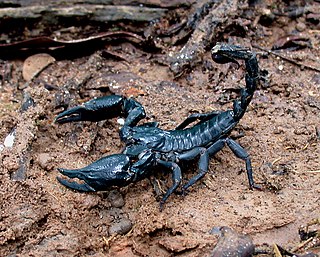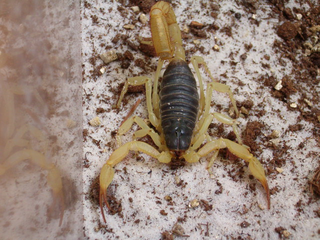
Scorpions are predatory arachnids of the order Scorpiones. They have eight legs and are easily recognized by a pair of grasping pincers and a narrow, segmented tail, often carried in a characteristic forward curve over the back and always ending with a stinger. The evolutionary history of scorpions goes back 435 million years. They mainly live in deserts but have adapted to a wide range of environmental conditions, and can be found on all continents except Antarctica. There are over 2,500 described species, with 22 extant (living) families recognized to date. Their taxonomy is being revised to account for 21st-century genomic studies.

The emperor scorpion(Pandinus imperator) is a species of scorpion native to rainforests and savannas in West Africa. It is one of the largest scorpions in the world and lives for 6–8 years. Its body is black, but like other scorpions it glows pastel green or blue under ultraviolet light. It is a popular species in the pet trade, and is protected by CITES to prevent over-collecting that might affect the species' survival.

Kappa- Hefutoxin 1 and 2 are toxins from the venom of the Asian forest black scorpion Heterometrus fulvipes with a unique structure. It blocks the potassium channels Kv1.2 and Kv1.3 and slows the activation of Kv1.3.

Gigantometrus swammerdami, commonly called the giant forest scorpion, is a scorpion belonging to the family Scorpionidae. It is native to India and is the world's largest scorpion species at 23 cm in length, and weighs 56 g (2.0 oz).

Hadogenes troglodytes is a species of scorpion from southern Africa. It is commonly known as the flat rock scorpion and commonly sold on the exotic pet market. It was once regarded as having the longest recorded body length of any scorpion, reaching up to 20 cm; however Heterometrus swammerdami currently holds the record for being the world's largest scorpion at 9 inches (23 cm) in length. May be confused with Hadogenes bicolor.

Heterometrus, whose members are also known by the collective vernacular name Asian Forest Scorpion, is a genus of scorpions belonging to the family Scorpionidae. It is distributed widely across tropical and subtropical southeastern Asia, including Indonesia, Brunei, Malaysia, Myanmar, Philippines, Singapore, Cambodia, Laos, Thailand, Vietnam, India, and China (Hainan). It is notable for containing some of the largest living species of scorpions.

Heterometrus laoticus or Vietnam forest scorpion, is a scorpion species found in peaty areas of Vietnam and Laos. They can reach lengths of 12 cm (4.7 in). They are a communal species, but cannibalism has been known to occur, and if caught, they can be extremely violent even towards their own kind.
Heteroscopine (HS-1) is the main component of the venom of Heterometrus laoticus. It belongs to the Scorpine toxin family. It is a polypeptide consisting of a defensin-like component on its N-terminal end and a putative potassium channel blocking component on its C-terminal end. It has antimicrobial effect on some bacteria, but not on fungi.

Scorpionidae is a family of burrowing scorpions or pale-legged scorpions in the superfamily Scorpionoidea. The family was established by Pierre André Latreille, 1802.

Heterometrus spinifer, or its common name, Malaysian forest scorpion, is a species of scorpions belonging to the family Scorpionidae.
H. nepalensis may refer to:
Srilankametrus gravimanus is a species of scorpion belonging to the family Scorpionidae. It is native to India and Sri Lanka.

Srilankametrus indus, commonly known as the giant forest scorpion, is a species of scorpions belonging to the family Scorpionidae. It is native to India and Sri Lanka.

Hadrurus is a genus of scorpions which belongs to the family Hadruridae. They are found in sandy deserts and other xeric habitats in northwestern Mexico and in southwest United States. They are among the largest of all scorpion genera, only surpassed by Hadogenes, Pandinus, Heterometrus and Hoffmannihadrurus.
HsTx1 is a toxin from the venom of the scorpion Heterometrus spinifer. HsTx1 is a very potent inhibitor of the rat Kv1.3 voltage-gated potassium channel.
Heterometrus serratus is a species of scorpion in the family Buthidae endemic to Sri Lanka where it is restricted to southern parts.
Srilankametrus yaleensis is a species of scorpion in the family Scorpionidae endemic to Sri Lanka.










